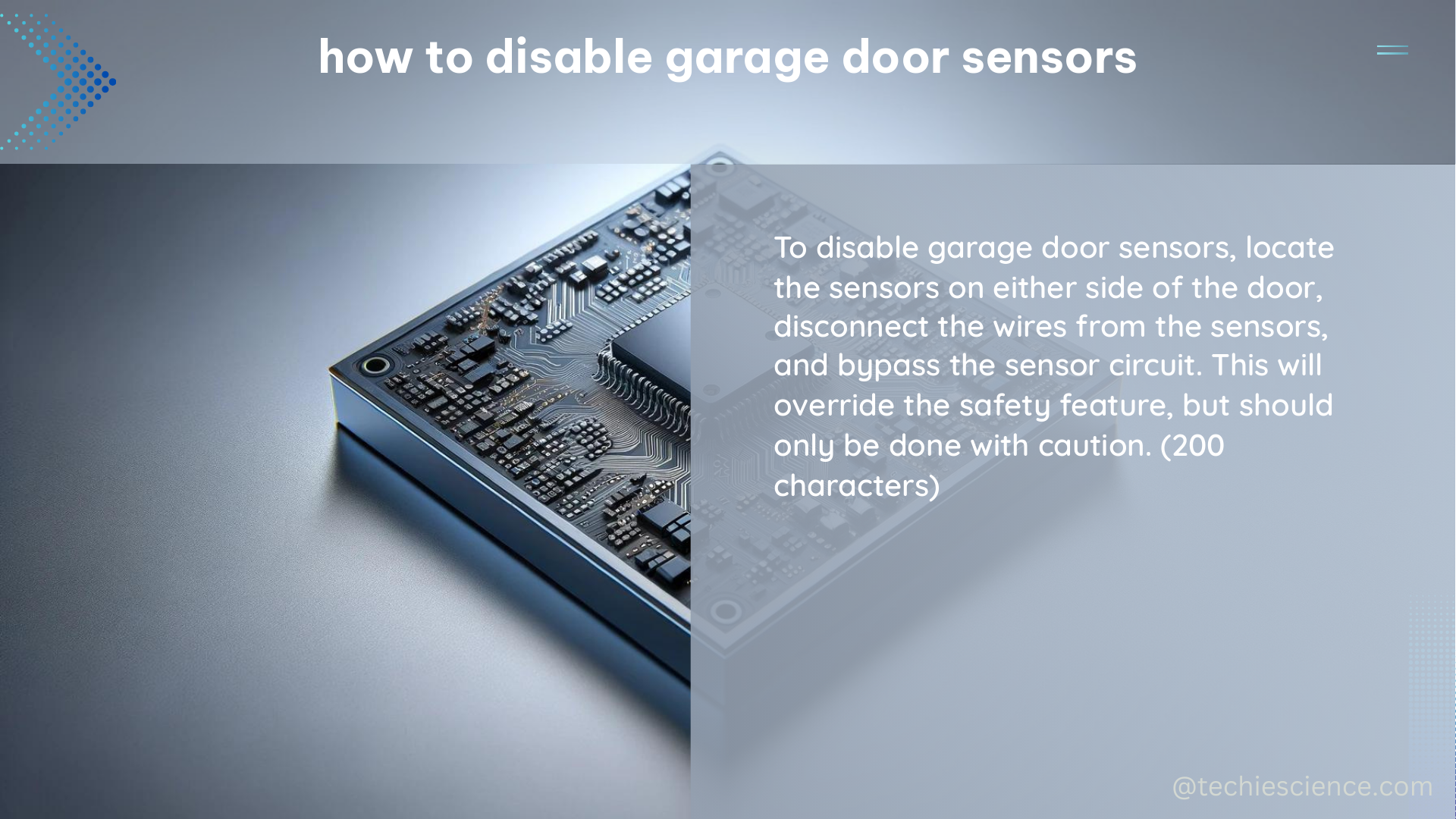Garage door sensors are an essential safety feature, using infrared technology to detect obstructions and prevent the door from closing, ensuring the safety of people and property. However, there may be instances where you need to temporarily or permanently disable these sensors. This comprehensive guide will walk you through the technical details and step-by-step instructions on how to disable garage door sensors safely and effectively.
Understanding Garage Door Sensor Technology
Garage door sensors typically consist of two main components: an emitter and a receiver. The emitter generates a beam of infrared light that is detected by the receiver. When the infrared beam is interrupted, the sensors signal the garage door opener to stop or reverse the door’s movement, preventing potential accidents or damage.
The technical specifications of these sensors can vary depending on the manufacturer and model, but they generally operate within the following parameters:
- Infrared wavelength: 850-950 nanometers (nm)
- Beam width: 3-6 inches (7.6-15.2 cm)
- Beam range: 4-40 feet (1.2-12.2 meters)
- Power supply: 12-24 volts DC or AC
- Current draw: 30-100 milliamps (mA)
It’s important to note that the exact specifications may differ, so it’s crucial to consult the owner’s manual or manufacturer’s documentation for your specific garage door opener model.
Disabling Garage Door Sensors: Methods and Considerations

There are a few methods you can use to disable garage door sensors, each with its own advantages and disadvantages. It’s essential to carefully consider the implications and potential risks before attempting any of these techniques.
Method 1: Shorting the Sensor Wires
One way to disable the garage door sensors is to short the sensor wires together. This can be done by connecting the two white wires and the two black wires, then attaching them to the corresponding terminals on the garage door opener.
Steps:
1. Locate the sensor wires, typically two white wires and two black wires, connected to the garage door opener.
2. Disconnect the sensor wires from the opener terminals.
3. Connect the two white wires together and the two black wires together using wire nuts or other suitable connectors.
4. Attach the connected white and black wire pairs to the corresponding terminals on the garage door opener.
Considerations:
– This method may not work for all garage door opener models, so it’s crucial to consult the owner’s manual or manufacturer’s instructions.
– Shorting the sensor wires can potentially damage the garage door opener, so exercise caution and ensure the power is disconnected before attempting this.
– Disabling the sensors can increase the risk of accidents and property damage, so this should be a last resort option.
Method 2: Using a Reflector or Tape
Another approach to disabling garage door sensors is to use a reflector or tape to bounce the infrared light back towards the sensor, tricking it into thinking the path is clear.
Steps:
1. Locate the sensor emitter and receiver components.
2. Place a reflective surface, such as a small mirror or a piece of aluminum foil, in front of the receiver sensor.
3. Alternatively, apply a reflective tape or sticker over the receiver sensor to create a reflective surface.
Considerations:
– This method may not work as effectively as shorting the sensor wires, as the reflector or tape can become misaligned or lose its reflective properties over time.
– The reflector or tape may need to be adjusted or replaced periodically to maintain the desired effect.
– As with the wire-shorting method, disabling the sensors can increase the risk of accidents and property damage.
General Considerations
Regardless of the method you choose, it’s essential to keep the following considerations in mind:
- Consult the owner’s manual or manufacturer’s instructions for your specific garage door opener model before attempting any modifications.
- Disabling the sensors can have legal and insurance implications, as building codes and regulations often mandate the use of these safety features.
- Prioritize troubleshooting and addressing any underlying issues with the sensors instead of bypassing them, as this is the safer and more responsible approach.
- If you must disable the sensors, exercise extreme caution and ensure that the garage door is not used until the sensors are properly reinstalled and tested.
Conclusion
Disabling garage door sensors should be a last resort option, as these safety features are in place to protect people and property. However, if you find it necessary to temporarily or permanently disable the sensors, this guide has provided you with the technical details and step-by-step instructions to do so safely and effectively.
Remember to always consult the manufacturer’s instructions, consider the legal and safety implications, and prioritize troubleshooting and addressing any underlying issues with the sensors. By following these guidelines, you can navigate the process of disabling garage door sensors with confidence and minimize the risks associated with this task.
References:
- Bypassing/Emulating Garage Door Opener Safety Sensors
- How to Bypass Garage Door Sensor
- Disabling Garage Door Sensors

The lambdageeks.com Core SME Team is a group of experienced subject matter experts from diverse scientific and technical fields including Physics, Chemistry, Technology,Electronics & Electrical Engineering, Automotive, Mechanical Engineering. Our team collaborates to create high-quality, well-researched articles on a wide range of science and technology topics for the lambdageeks.com website.
All Our Senior SME are having more than 7 Years of experience in the respective fields . They are either Working Industry Professionals or assocaited With different Universities. Refer Our Authors Page to get to know About our Core SMEs.